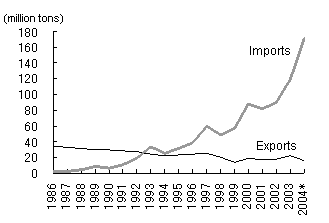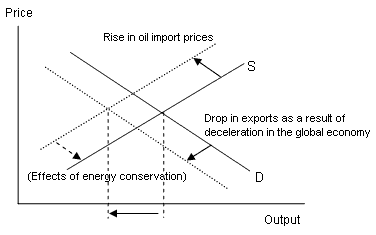Oil prices temporarily topped the $50 per barrel mark in late September, reaching record-high levels. While an increase in demand in China is seen as one factor behind the surge, on the other hand, the rise in oil prices threatens to suppress China's economic growth. At the time of the first oil shock, Japan overcame that difficult situation through vigorous pursuit of energy conservation in order to cut production costs; now it is China's turn.
Against the backdrop of rapid industrialization and motorization, China has overtaken Japan to become the world's second largest consumer of oil. While China's oil exports have declined in recent years, its imports are soaring in line with the rise in domestic oil consumption. China shifted from being a net oil exporter to a net oil importer in 1993 and net imports have been increasing ever since. In 2003, imports of crude oil and petroleum products totaled 119.36 million tons ($25.7 billion in value terms) and even after subtracting exports, net imports topped the 100-million-ton level, coming to 103.1 million tons ( chart 1 ). As a result, the deficit in China's oil trade came to $20.3 billion last year. Given the further rise in oil prices so far this year, the figure is expected to exceed $30 billion (roughly 2% of gross domestic product) in 2004.
The rise in oil prices affects the Chinese economy in three ways ( chart 2 ). First, higher oil prices translate to higher production costs for Chinese manufacturing firms. So while prices rise, output falls. (The supply curve shifts to the left.) At the same time, because the industrialized countries that are the major importers of goods made in China are similarly affected by a rise in oil prices, China's exports drop as a result of the deceleration of the global economy and production decreases even further. (The demand curve shifts to the left.) Furthermore, a rise in oil prices signifies a deterioration in China's terms of trade (the relative price of exports vis-a-vis imports), and the purchasing power of China's national income declines accordingly. When we consider that China's net oil imports come to $30 billion annually, a 10% rise in oil prices means that China's import costs rise by an additional $3 billion. This is equivalent to an income transfer from China to oil exporters, and at some point this becomes a public burden in the form of lower corporate earnings and higher consumer prices.
The rise in oil prices is largely a "supply-side shock" that requires countermeasures on the supply side rather than macroeconomic measures that stimulate demand. Among such measures, as the experience of many industrialized countries including Japan has shown, energy conservation measures are the most effective. By boosting energy efficiency, production costs will fall and output will rise (shifting the supply curve to the right). Of course, such measures will require investment, but the more expensive oil becomes, the more profitable investments in energy-saving measures will be. In addition, compared to Japan during the first oil shock, China should be able to obtain more advanced energy-saving technology at a lower cost from international markets.
Up to now, China has viewed environmental protection and economic development as two objectives that cannot be met simultaneously; like many developing countries, the government has chosen to "place priority on economic development even at the cost of the environment." As in Japan's case, there are "success stories" where it was possible to tackle environmental issues after completing the industrialization process, and China has so far failed to adopt sufficient environmental protection policies. However, recognition is spreading that large-scale energy consumption not only causes environmental damage such as air pollution and resource depletion, but also adversely affects the international competitiveness of industry and hampers economic growth through higher costs. In fact, post-oil shock Japan managed to simultaneously clean up its environment and boost its international competitiveness through energy conservation efforts ( note ). This is the lesson China should learn from Japan's experience.
Chart 1: China's oil exports and imports

(Note) Total for crude oil and petroleum products.
* The figure for 2004 is a projection based on year-on-year growth for the first half of the year.
(Source) People's Republic of China Customs Statistics
Chart 2: Effects of higher oil prices on China's economy

(Source) The author


